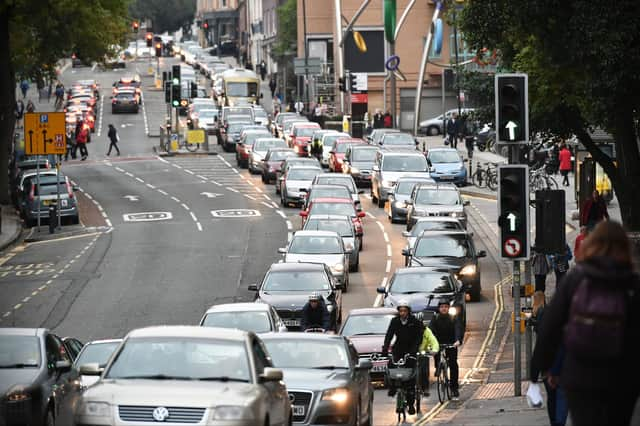Here's the full list of UK cities expected to introduce Clean Air Zones - and what they mean for drivers


Clean Air Zones (CAZ) are being introduced in parts of the UK in a bid to improve air quality.
The scheme officially started in Birmingham this week on 14 June, with drivers of older, more polluting cars required to pay a daily fee to drive through the city centre.
Advertisement
Hide AdAdvertisement
Hide AdHundreds of thousands of drivers are expected to be affected by the charge, which the city council says is a vital part of efforts to reduce pollution in the area.
It follows the launch of the UK’s first Ultra Low Emission Zone in London in 2019.
But the Birmingham CAZ has proved controversial, with fears over its impact on poorer drivers and the post-Covid recovery of businesses.
So, what are Clean Air Zones, which other regions have them - and where else is planning to introduce them?
Here’s what you need to know.
What are Clean Air Zones?
Advertisement
Hide AdAdvertisement
Hide AdA Clean Air Zone is an area where targeted action is being taken to make air quality better.
It can constitute a single road or a part of a city.
Where it is introduced, drivers of vehicles not meeting emission standards may face a daily fee.
The schemes are being implemented in parts of the UK as part of the government’s long-term strategy to improve air quality across the country and tackle the climate emergency.
It wants to discourage the use of older, more polluting vehicles, with the aim of reducing the number of areas in the UK where air pollution breaches legal limits.
Advertisement
Hide AdAdvertisement
Hide AdHowever, it is local authorities that are responsible for introducing a CAZ and they are only able to set charges at levels designed to reduce pollution.
Councils were asked to create a plan for improving air quality and submit it to the government, and, if approved, the local authority is able to receive funding to help set up a CAZ.
What are the different types of CAZ?
Local authorities are also able to decide what level of restrictions to apply. There are four classes of CAZ, ranging from Class A to D:
- Class A - Buses, coaches, taxis and private hire vehicles
- Class B - Buses, coaches, taxis, private hire vehicles, heavy goods vehicles
- Class C - Buses, coaches, taxis, private hire vehicles, heavy goods vehicles, vans, minibuses
- Class D - Buses, coaches, taxis, private hire vehicles, heavy goods vehicles, vans, minibuses, cars, the local authority has the option to include motorcycles.
However, there are some exemptions.
Charges or restrictions will not apply to buses, coaches and heavy goods vehicles that meet Euro VI emissions standards, along with cars, vans and taxis that meet Euro 6 (diesel) or Euro 4 (petrol) emissions standards.
Advertisement
Hide AdAdvertisement
Hide AdThe same goes for ultra-low emission vehicles with a significant zero-emission range.
Which regions already have the zones?
There are only two cities in the UK with Clean Air Zones - Birmingham and Bath.
Birmingham’s new scheme is a Class D zone, whereas Bath’s is Class C.
The Bath scheme started on 15 March 2021, but doesn’t levy a fee on privately owned cars - just drivers of non-compliant taxis who pay £9 a day, and older coaches, buses and lorries who have to pay £100.
Advertisement
Hide AdAdvertisement
Hide AdMeanwhile, the Birmingham scheme, which is enforced using Automatic Number Plate Recognition (ANPR), affects all vehicles, including diesel cars that don’t meet the Euro 6 emissions standard and petrol cars that don’t meet the Euro 4 standard.
Drivers of these cars need to pay £8 a day when driving inside the A4540 Middleway ring road, and the scheme applies 24 hours a day every day of the year.
And the charge is £50 for HGVs and coaches, unless a valid exemption is in place.
People also face a hefty fine of £120 if they don’t pay the fee.
Where else will Clean Air Zones be introduced?
Advertisement
Hide AdAdvertisement
Hide AdMore UK cities will be implementing Clean Air Zones later this year and in 2022.
That includes:
- Bristol - 29 October 2021 (expected)
- Bradford - October 2021 (expected)
- Leicester - Summer 2021 (expected)
- Manchester - Spring 2022
- Newcastle - Late 2021
- Portsmouth - November 2021
- Sheffield - Late 2021
- Oxford (Zero Emissions Zone) - August 2021.
London’s ULEZ will be expanded to cover more roads from 25 October 2021.
A CAZ was also proposed for Leeds but has since been scrapped as pollution levels in the city dropped significantly when hundreds of taxi and van drivers used grants to help pay for them to upgrade their vehicles.
Meanwhile, the Scottish Government plans to have four Low Emission Zones (LEZ) operating by May 2022, with the first already introduced in Glasgow for buses.
The zones will next be implemented in Edinburgh, Aberdeen and Dundee, while the Glasgow LEZ will be extended to cover all vehicle types by 2022.